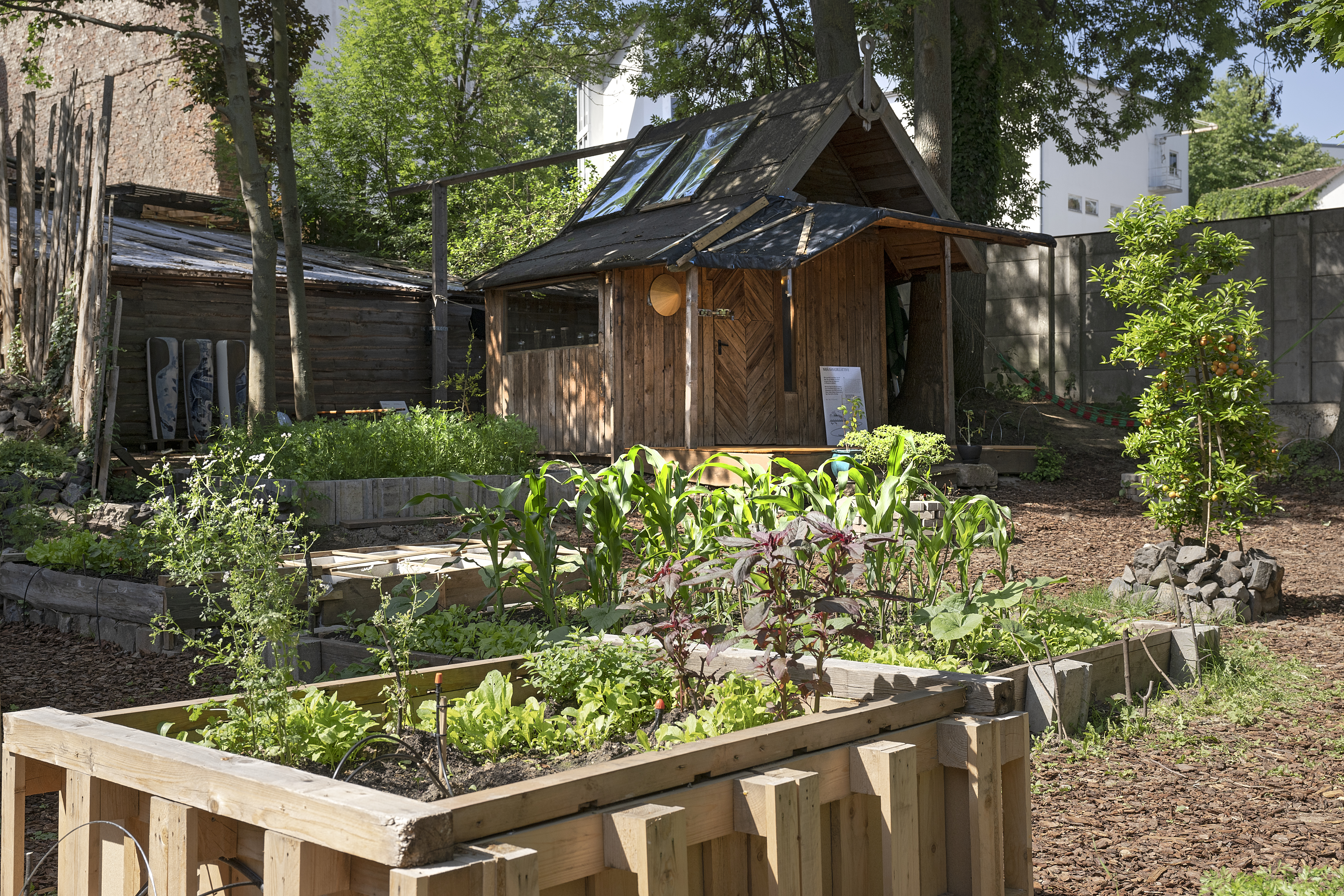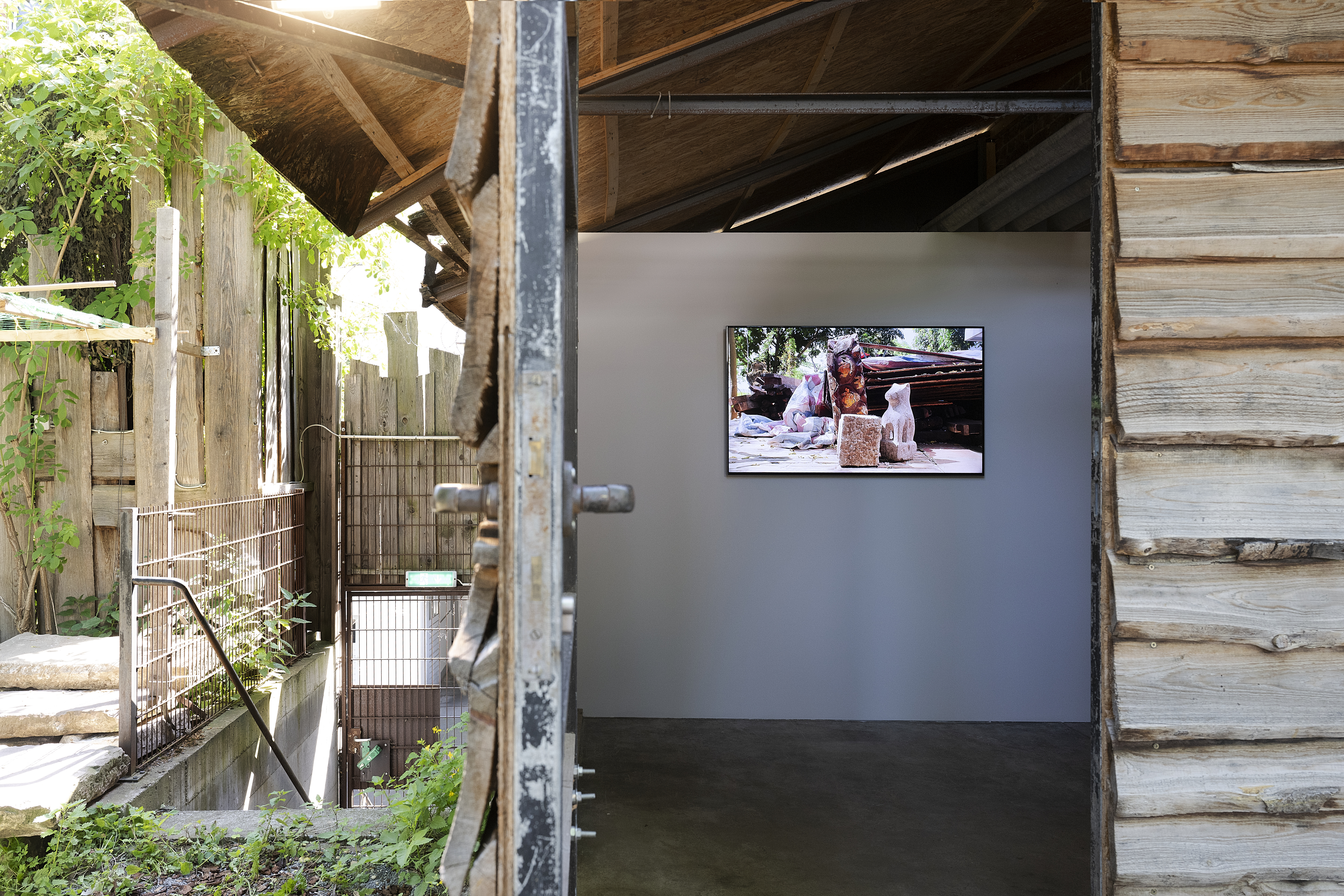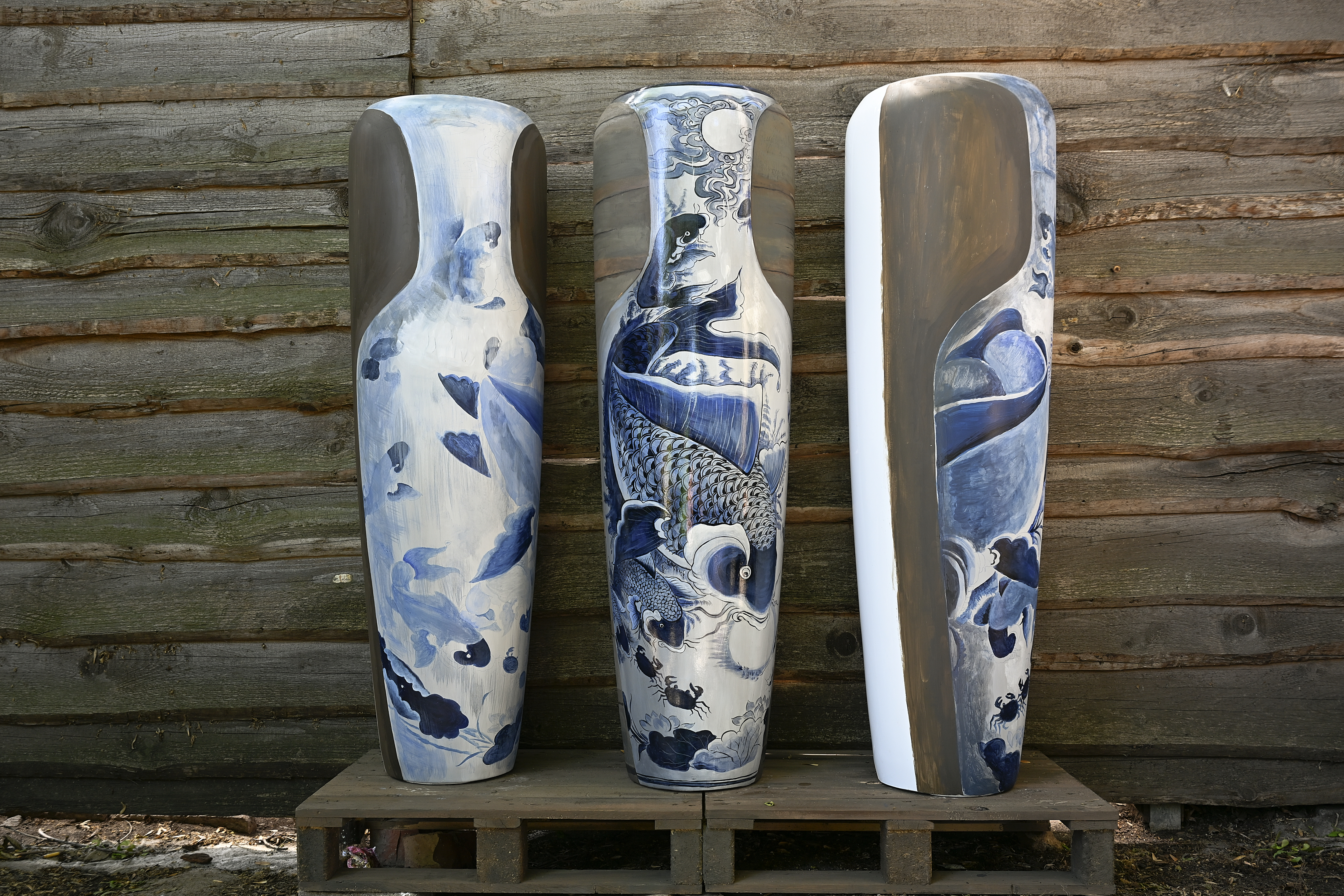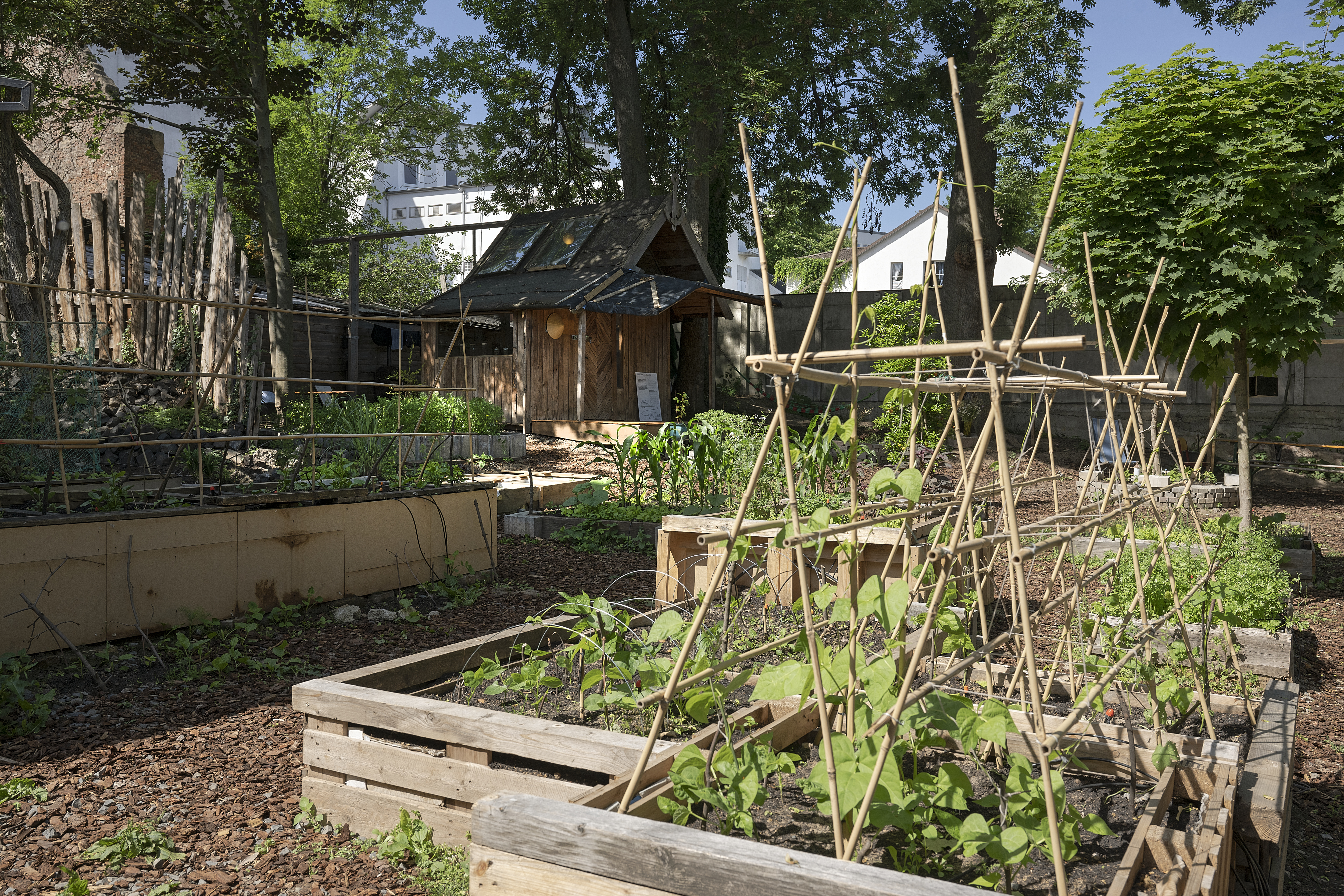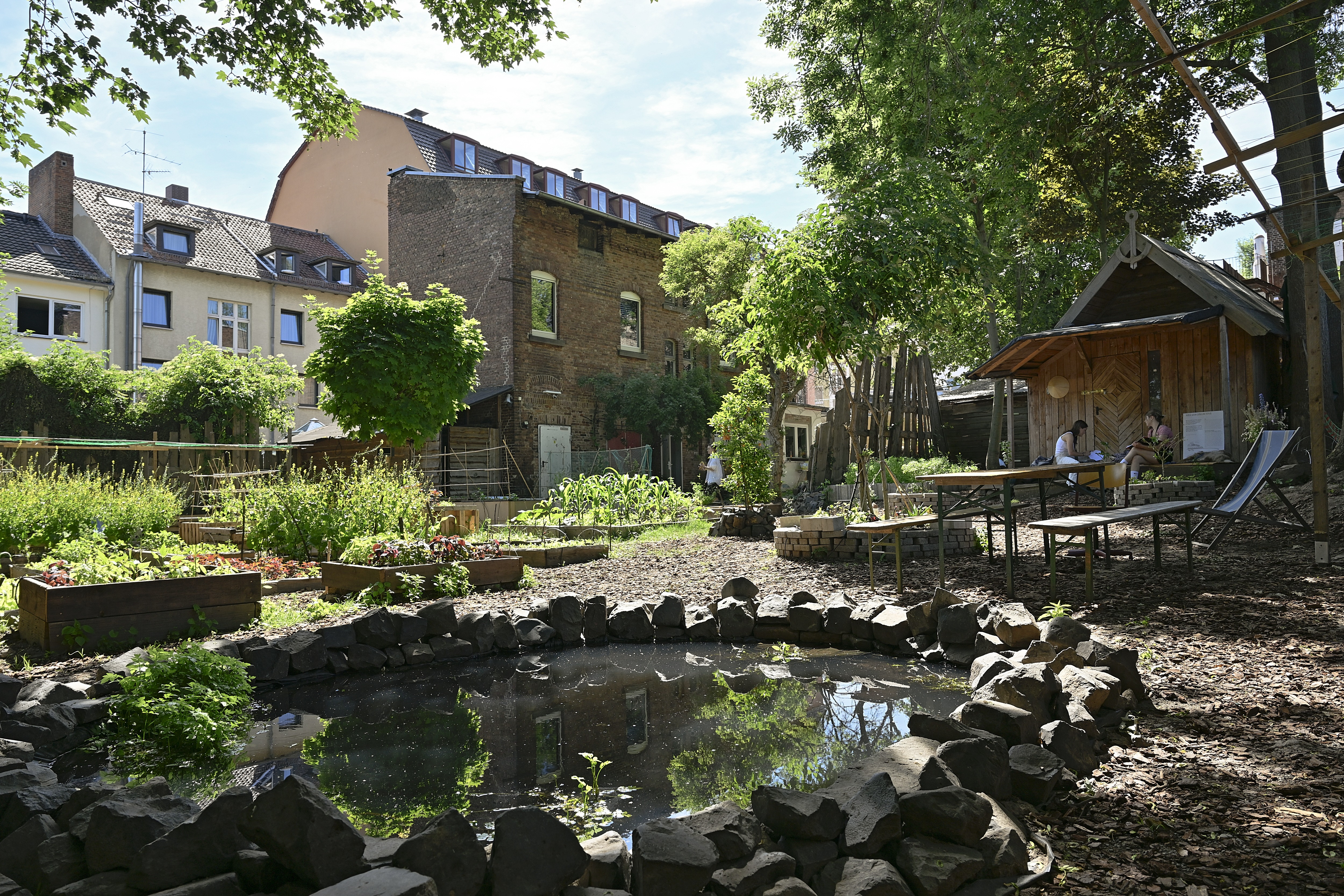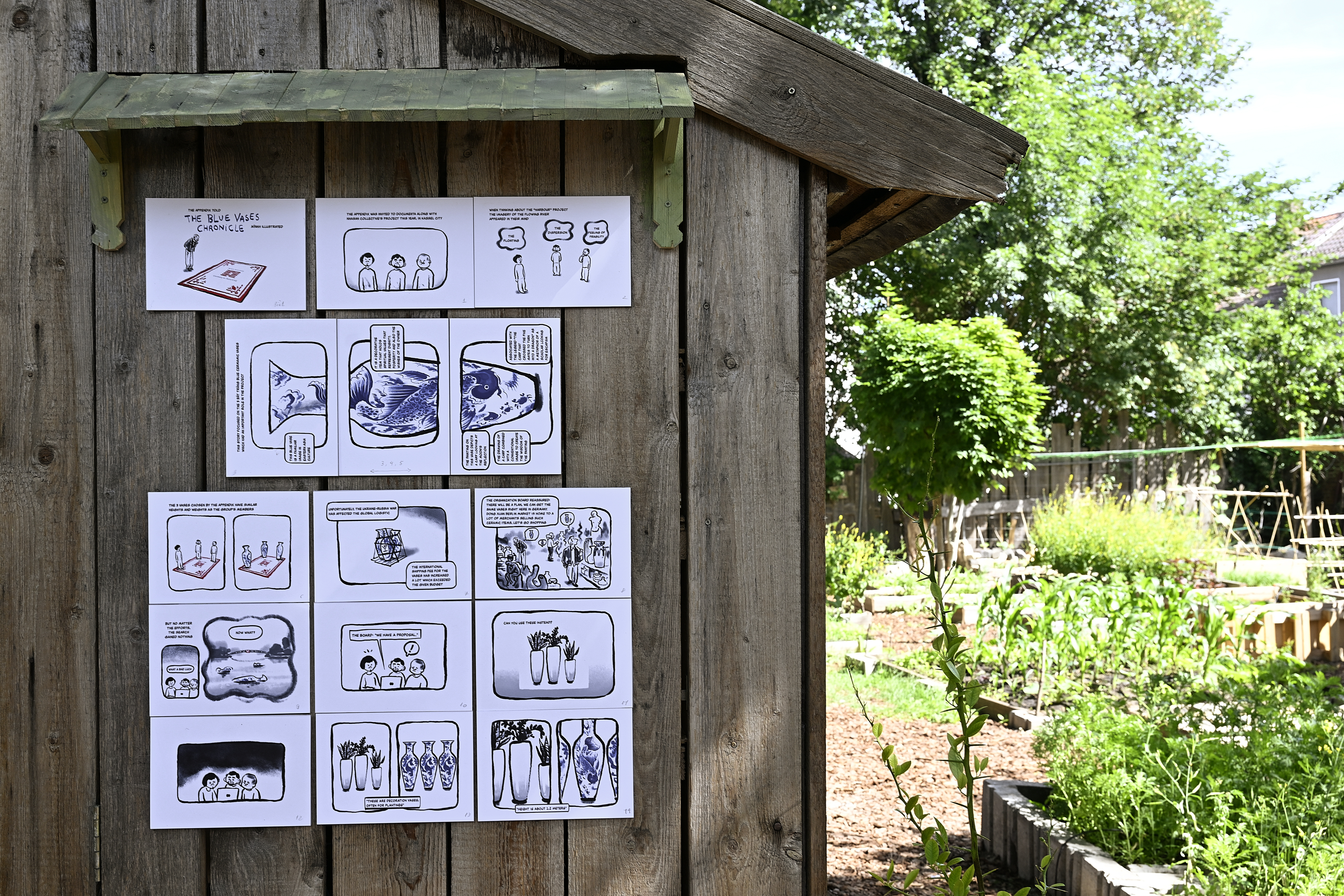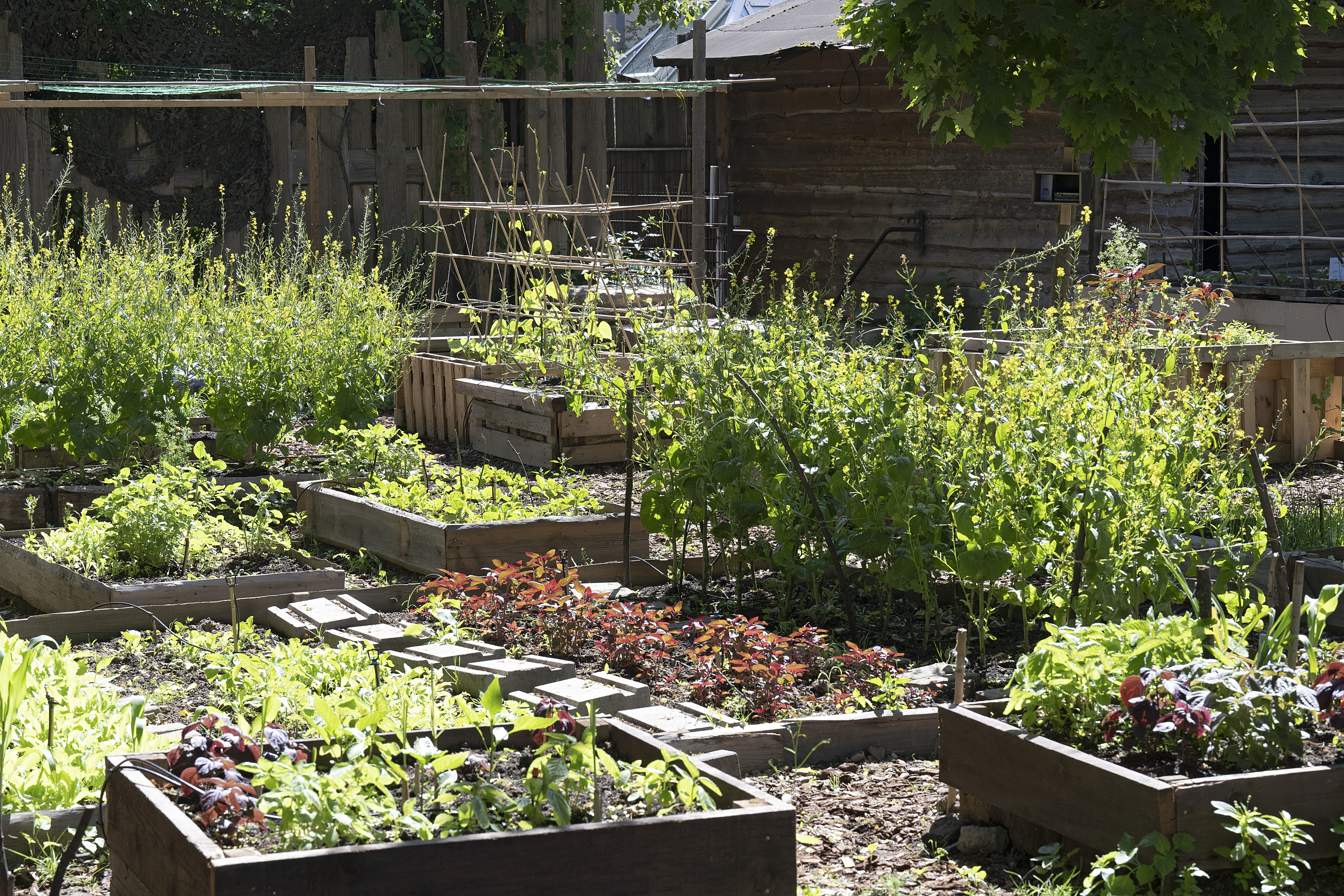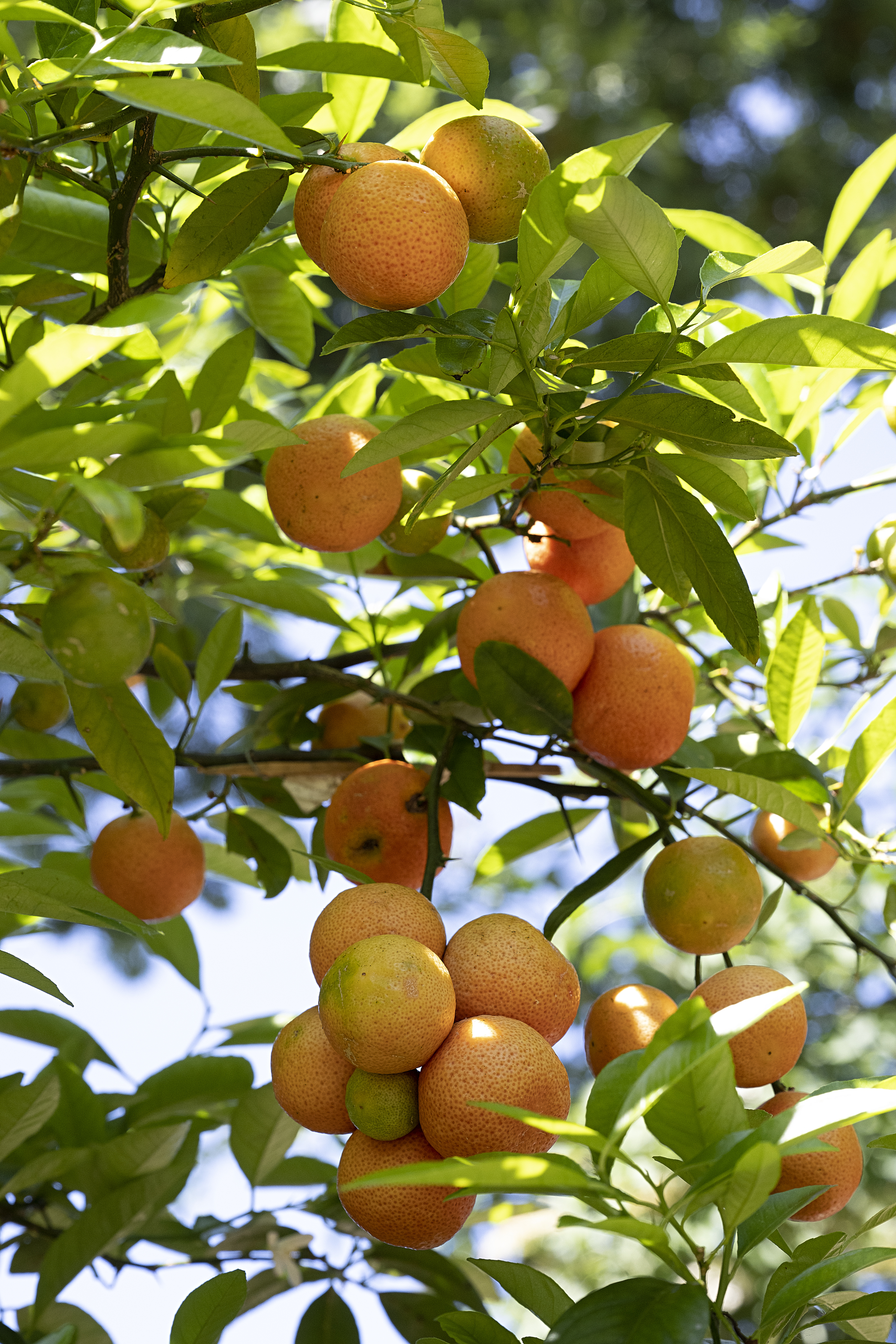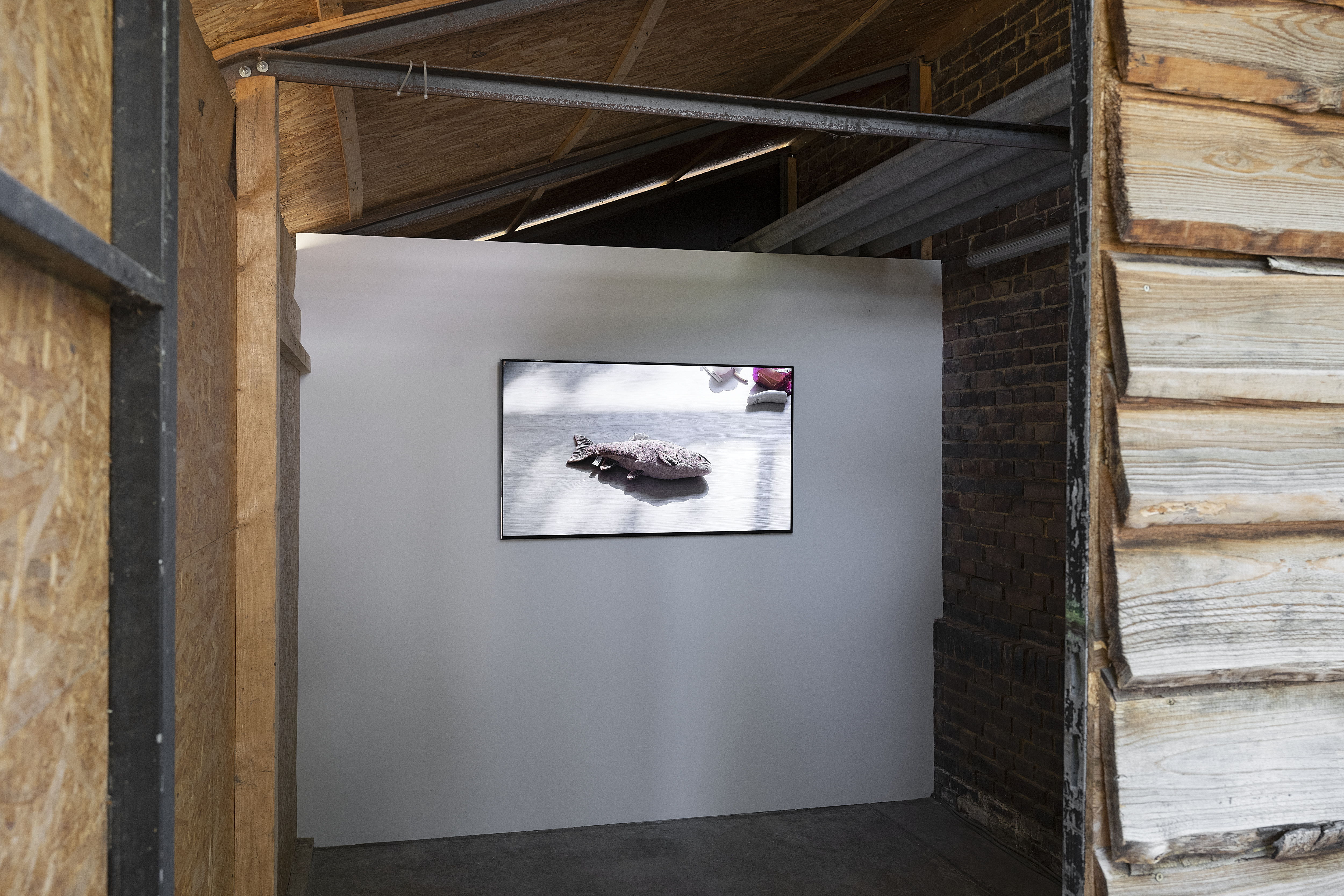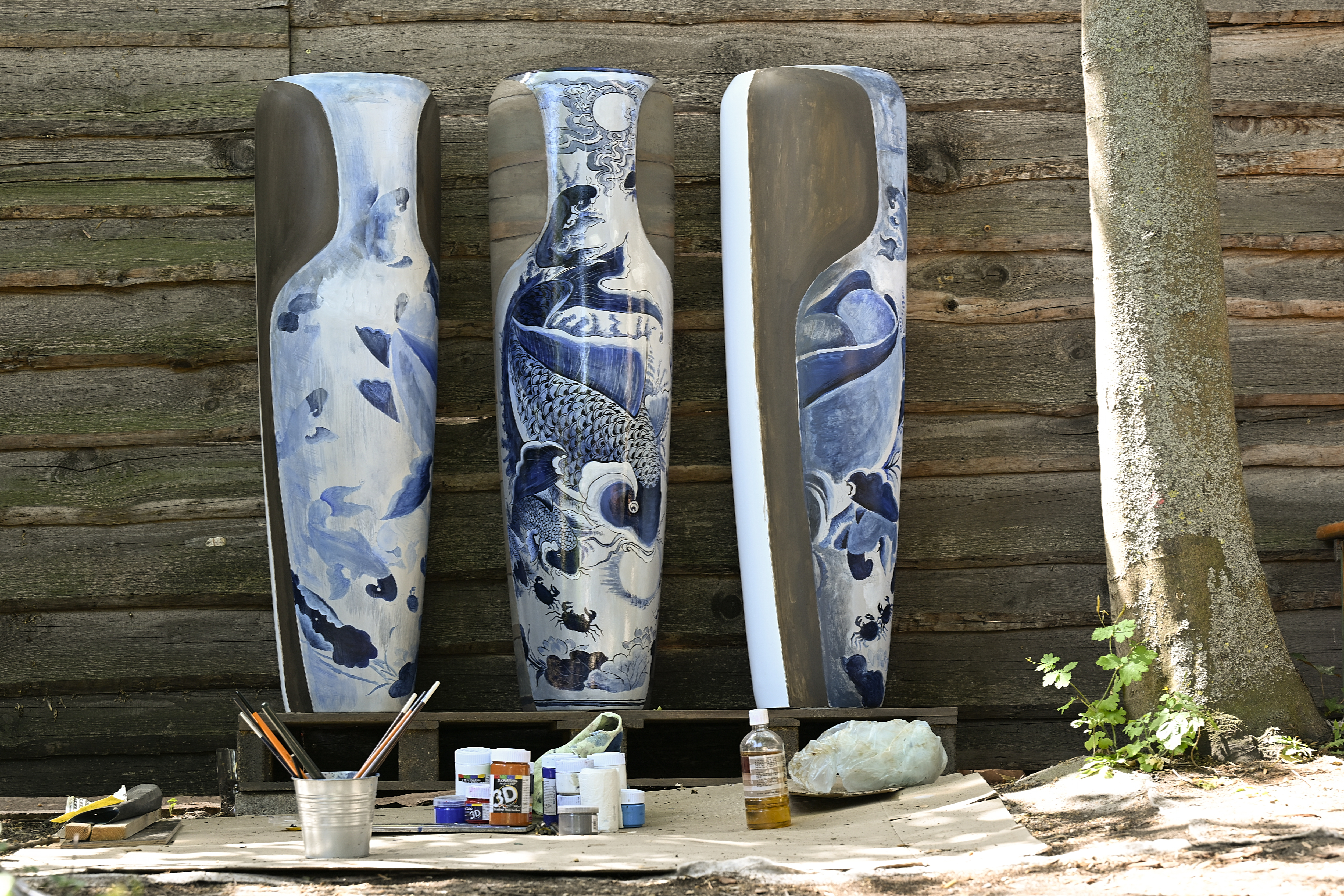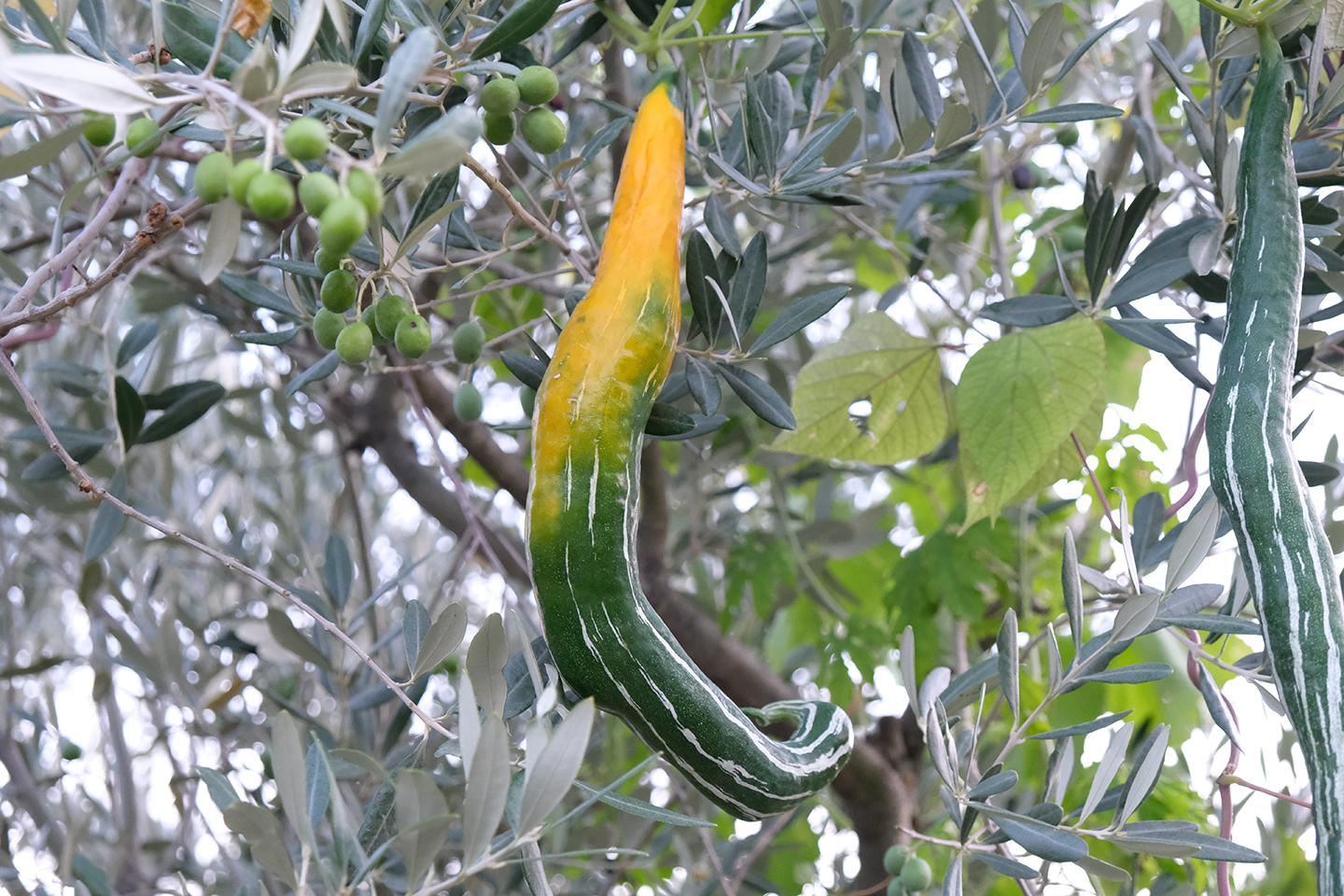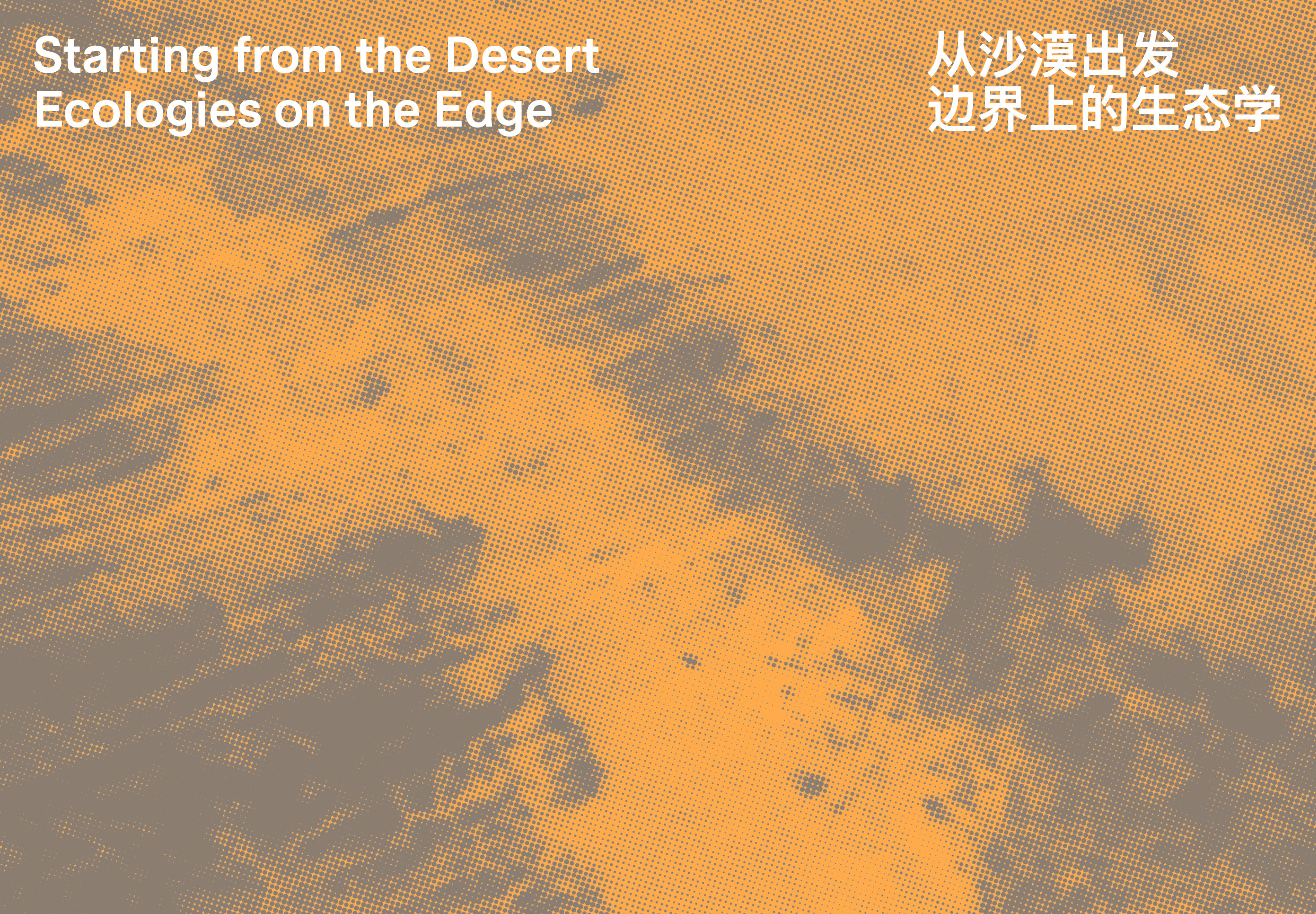If Documenta 13 claimed to unfold like “an organism, like a vegetable bud,” then Documenta 15 gleans crops and distributes the harvest. [footnote See →.] ruangrupa, the curatorial collective behind Documenta 15, has framed their organizing agenda around the lumbung’s communal harvest, a resource-sharing endeavor that counters neoliberal logics and climate crises. Documenta 15 also organizes its artistic perspective from the Global South, particularly Southeast Asia. The curators state that “harvesting can be seen as a way of collective writing that enables continuous collective learning, from different sensory experiences.” [footnote ruangrupa, Documenta 15 Handbook (Ostfildern, Germany: Hatje Cantz, 2022), 42.] Many works in the exhibition directly address a circular economy not just theoretically but materially, which is genuinely distinct for the quinquennial. It should come as no surprise then to encounter several horticultural projects in the exhibition, many of which also look to Southeast Asian immigrant communities within Germany itself, including its large Vietnamese community.
Works engaging with environmental concerns have been a feature of Documentas past. Well known across the Kassel landscape is Joseph Beuys’s 7000 Oaks, from Documenta 7 in 1982, in which the artist planted 7000 trees alongside basalt columns throughout the city. Documenta 13, in 2012, included works that were “ecologically” “entangled,” buzzwords worth interrogating as they are often used with ambiguity: Pierre Hugyhe’s beehive sculptures made their debut, Maria Thereza Alves’s installation gracefully tracked man-made disaster in Chalco, Mexico, and Song Dong presented a yassified mound of organic waste that was quarantined from the public amid the manicured fields of Kassel’s Orangerie. While these works are generally hands-off propositions intentionally cloistered from public intrusion for aesthetic and conservation purposes, Documenta 15 has encouraged direct engagement with nature through the planting of seeds, the gathering of divergent communities, and the harvesting and sharing of histories, ideas, and resources. [footnote Even the opening image to the exhibition’s book is an illustration by Daniella F. Praptono likening a timeline of this Documenta to a pastoral landscape filled with trees, rivers, and rhizomes.] Unpretentious relational-aesthetic gardens or gardens-as-social-practice can be found throughout the exhibition, but none are as inviting as Nhà Sàn Collective’s offering.
Founded as Nhà Sàn Studio in 1998—the first alternative art space in Vietnam—Nhà Sàn reformed as an artist collective to support and nurture contemporary art in Hanoi. At Werner-Hilpert-Strasse 22 (WH22), the collective’s leafy installation confronts viewers in an otherwise postindustrial and postcommercial setting: the back of a former nineteenth-century wine shop that was until recently an empty lot. Nhà Sàn’s project consists of repurposing vacant urban space with a labyrinth of raised planting beds filled with willowy and untamed plants initiated by collective member Tuấn Mami, a woodshed with a porch displaying the garden’s yield alongside works by the Nhà Sàn-invited collective Phụ Lục (The Appendx Group), and a smaller improvised shed-cum-screening room with a video by Quynh Dong.
On first view, Mami’s Vietnamese Immigrating Garden recalls the private Schrebergarten that fill the margins of Germany’s larger cities as extensions of the home, but the allotment at WH22 specifically includes propagating flora prevalent in Vietnam and is open to the public. [footnote Schrebergärten were first known as “gardens of the poor” in the mid-nineteenth century but came to be essential sources of food for German families during World Wars I and II.] The collective invited Vietnamese immigrants in Germany to donate seeds from their homeland that are often considered contraband by Germany’s Federal Ministry of Food and Agriculture and in Mami’s work are neatly arranged on shelves in the larger shed and displayed in jars with delicate handwritten bilingual labels. Also on view are extensive plant glossaries and eighteenth-century illustrations of animals and flora by British naturalist George Shaw. A video and three notebooks on-site document the contributors to and collective process of building the garden, which will continue as a harvest through the exhibition’s hundred days. Behind the shed is Phụ Lục’s The Chronical of the Blue Vases, three tall plastic vases performing as authentic Bât Trâng-style ceramics with blue and white carp painted on their faces. Human-scale and standing in for the collective members themselves, they are accompanied by a comic strip recounting the logistical nightmares of the supply chain crisis and miscommunication with Documenta administration about the installation. In a perhaps ironic gesture, the work is presented on a shipping pallet. In the smaller shed, on the other side of the patch filled with corn, gourds, citrus, flowers, and herbs grown in Vietnamese Immigrating Garden, is the steady, slideshow-like video Poem Garden by Quynh Dong. Filmed in Vietnam, the video portrays the everyday lives of Nhà Sàn Collective members and juxtaposes these scenes with readings of the members’ favorite poems. Inspired by the heavenly and enchanted gardens in the Christian concept of hortus conclusus (enclosed garden), which is often analogized with the Virgin Mary’s walled off yet abundant womb, Quynh Dong produces an image of nature in which Western and Eastern references ambivalently mingle.
Distinctions between “social” and “environmental” problems are blurred here as the rewilding of abandoned space is taken up by local immigrant communities, whose needs and concerns are rarely addressed by the art world. Contrary to those environmental works in earlier Documentas, Nhà Sàn Collective’s garden seeks to engage different publics through the hybrid integration of many hands and the maintenance, consumption, and respite shared by many. And contrary to other works in this year’s exhibition, Nhà Sàn Collective’s work pairs the pleasant and accessible aesthetic experience of being shaded outdoors among plants with an untangling of the bounded environmentalism we often see separating environmental issues from social ones.
The collective’s work in Kassel directly references three histories of uneven power relations often repressed by both the Vietnamese and German states. In Europe and Southeast Asia, as well as throughout the world, agriculture has been instrumentalized on behalf of colonial and capitalist endeavors. For example, rubber plantations in Vietnam were almost exclusively owned by French companies but relied on Vietnamese labor prior to, throughout, and even after the Indochina wars. [footnote The rubber industry was driven, in part, by the United States’s penchant for the automobile. Michitake Aso, “Decolonizing Plantations,” in Rubber and the Making of Vietnam: An Ecological History, 1897–1975 (Durham: University of North Carolina Press, 2018), 217.] Germany’s own Lebensreform movement, a nineteenth-century response to modernity, encouraged closer relationships to nature through gardening and farming but was later taken up by ethno-nationalists and members of the Nazi Party as a way to purify an Aryan race, oppressively institutionalizing white supremacy through control of the land. And by the late 1980s, the Vietnamese community in East Germany had grown nearly two-thousand percent due to state communist relations and training programs between North Vietnam and the German Democratic Republic. Today, the Vietnamese community in Germany remains one of its largest Asian immigrant groups. [footnote Felicitas Hillmann, “Riders on the Storm: Vietnamese in Germany’s Two Migration Systems,” in Ernst Spaan, Felicitas Hillmann, and A.L. van Naerssen, eds., Asian Migrants and European Labour Markets, Patterns and Processes of Immigrant Labour Market Insertion in Europe. (London: Routledge, 2005), 80–100.] Nhà Sàn’s collectively operated garden offers a counternarrative to such histories where a vegetal dissidence rebels against the traditionally exploitative domination of nature. The presence of plants mediated through these artworks had blossomed and grown messy, moldy, wild, and beautiful as early as my visit in mid-July.
The global privatization and alienation of agriculture by companies like Nestlé or Monsanto has led to dire consequences such as forced labor, resource dispossession, and forced migration. Yet, seeds and people have always been mobile and become rooted thousands of miles from their native soils. They are governed and regulated but can also thrive in the most unexpected places when given support and opportunity. Phụ Lục’s plastic vases divert audiences from Edenic sentiments by reminding us of the emotional and material effects of war on global consumption. Quynh Dong’s Poem Garden introduces visitors to the individuals within the collective and Tuấn Mami’s Vietnamese Immigrating Garden circumvents the law to make space for growth and pleasure. Nhà Sàn Collective has not presented the garden as a paradise, a distortion of nature for purely aesthetic ends, nor a finite structural solution to obstacles of sovereignty. Instead, in the spirit of lumbung, it has fostered and communicated a liberatory relational politics of people to land beyond the state.
See →.
ruangrupa, Documenta 15 Handbook (Ostfildern, Germany: Hatje Cantz, 2022), 42.
Even the opening image to the exhibition’s book is an illustration by Daniella F. Praptono likening a timeline of this Documenta to a pastoral landscape filled with trees, rivers, and rhizomes.
Schrebergärten were first known as “gardens of the poor” in the mid-nineteenth century but came to be essential sources of food for German families during World Wars I and II.
The rubber industry was driven, in part, by the United States’s penchant for the automobile. Michitake Aso, “Decolonizing Plantations,” in Rubber and the Making of Vietnam: An Ecological History, 1897–1975 (Durham: University of North Carolina Press, 2018), 217.
Felicitas Hillmann, “Riders on the Storm: Vietnamese in Germany’s Two Migration Systems,” in Ernst Spaan, Felicitas Hillmann, and A.L. van Naerssen, eds., Asian Migrants and European Labour Markets, Patterns and Processes of Immigrant Labour Market Insertion in Europe. (London: Routledge, 2005), 80–100.
